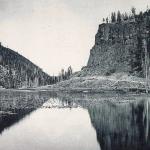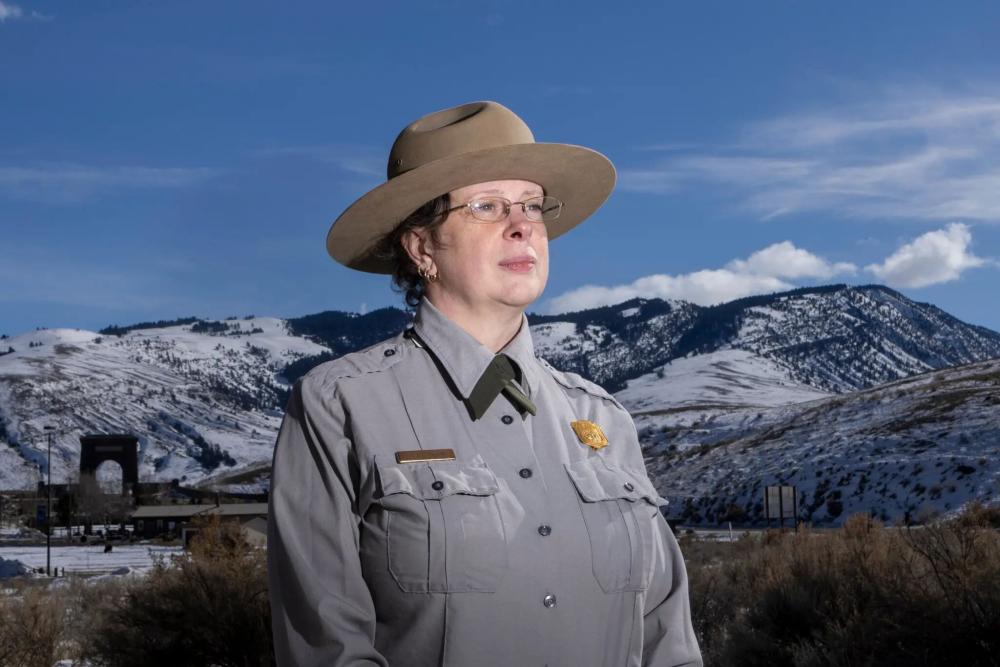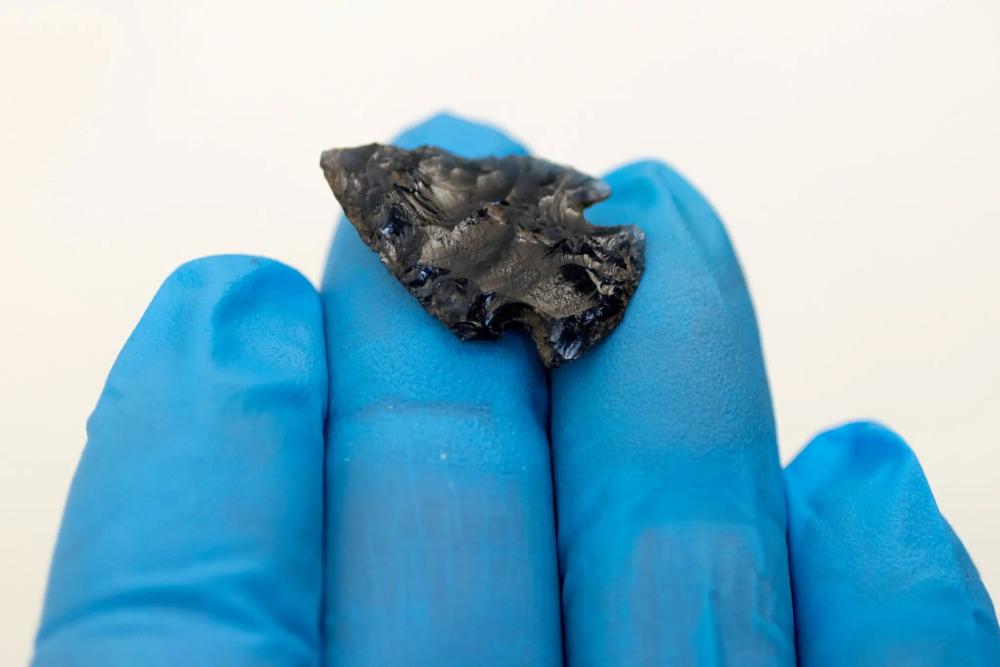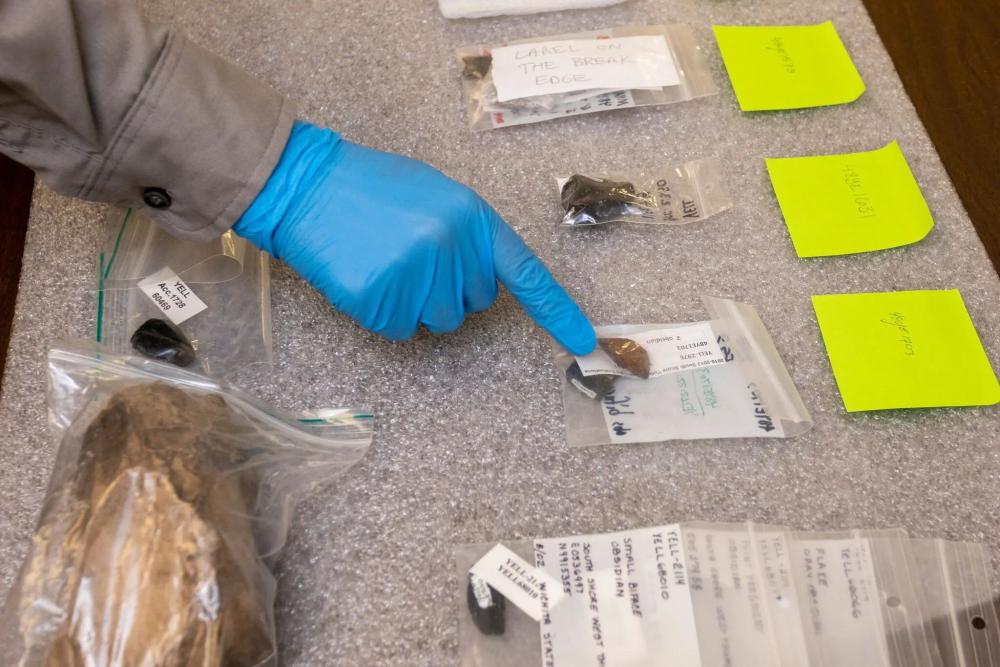Sunday Science: Obsidian Cliff – Humanity’s Tool Shed for the Last 11,500 Years

YELLOWSTONE NATIONAL PARK, Wyo. — Near the north entrance, an imposing mountain of black glass rises against the blue sky.
Spanning more than five square miles, the dark, sometimes translucent mass was formed from a rhyolitic lava flow that oozed out of the magma chamber of Yellowstone Caldera beneath the park, and cooled rapidly in the bitter cold of a glacial maximum, about 180,000 years ago.
Known as Obsidian Cliff, the Yellowstone mountain is one of the country’s highest quality deposits of “the sharpest natural substance on Earth,” according to Douglas H. MacDonald, a professor of anthropology at the University of Montana and the author of “Before Yellowstone: Native American Archaeology in the National Park.”
Obsidian is among the most prized tool stones in the world, and this particular deposit, nearly 100 feet thick, is exceptional because of its continual use by Indigenous people since the last ice age. Over the last 11,500 years or so, the stone has been fashioned into deadly knives, razor-sharp spear points, darts for atlatls, or spear-throwers, and arrowheads.
The cliff is “nationally significant because we had Native American groups from all over the country visiting it and collecting the stone and trading for it,” Dr. MacDonald said.
For modern day researchers, the obsidian columns of Yellowstone have helped to reveal the travels and migration of people thousands of years ago. X-ray fluorescence technology has been used to identify the unique geochemical fingerprint of each separate deposit of obsidian, pinpointing the provenance of artifacts found elsewhere. Obsidian from here has been found across the continent.
A fingerprint for the most prized tool stone in paleoindian cultures transformed the field. It provides a window into the past, a flow through both space and time over thousands and, in some places, millions of years. It opens up unknown and unimagined connections and deepens the understanding of migration, networking and trade in populations around the world.
“We can figure out where people are moving on the landscape and from there how the tools themselves reflect their strategies and culture,” said Elizabeth A. Horton, the archaeologist for Yellowstone, as she displayed obsidian knives and spear points from the park’s archives. “How did they interact with this landscape? Where did people go to visit? What was at that location?”
The application of X-ray technology to archaeology arose in the 1960s “and changed everything,” said M. Steven Shackley, director of the Geoarchaeological XRF laboratory in Albuquerque and author of “X-ray Fluorescence Spectrometry (XRF) in Geoarchaeology.” “Before that you had to infer. They either just guessed or didn’t do it.”
In recent decades, the technology has become easier to use, more portable and far less expensive.
The smooth, sensuous black glass has been an important part of hunter-gatherer cultures for about two million years, going back to Homo habilis, one of the first human ancestors who made crude stone tools. (A very modern reference would include the fictional land of Westeros, the setting for the HBO series “Game of Thrones,” where it was called dragon glass and made by “the fires of the earth.”)
Researchers are using the approach to study both newly discovered artifacts and to re-examine existing collections. Archaeologists at Yale recently deployed the X-ray fluorescence technology on obsidian artifacts that were gathered at the university’s Peabody Museum in the 1960s from two key sites in southwestern Iran.
The tools, which date back nearly 10,000 years, were originally believed to have come from two sources on the Deh Luran Plain in Iran. But the analysis showed that the volcanic glass came from seven places, including Nemrut Dağ, a dormant volcano that was more than 1,000 miles from the excavation sites in what is now southeastern Turkey and in Armenia. Those findings led to the realization that Neolithic social networks were much larger and settlements were more complex than originally thought.

Elizabeth Horton, a Yellowstone archaeologist. Natalie Behring for The New York Times
“Tracing these obsidian artifacts from their sources to their end points offers insight into how they moved from hand to hand to hand over time,” Ellery Frahm, an archaeological scientist at Yale and the lead author on the paper, said.
X-ray fluorescence can be done in the field with an instrument the size of a hand drill, reducing a process that used to take days or weeks to seconds.
The technique is being used widely across the American West, and Yellowstone has a number of projects underway.
The geochemical fingerprint of the cliff’s volcanic glass has been found all around the West, as well as in Canada. Area tribes “all knew about it, all the archaeological sites in Montana that are important have some form or another of obsidian, and most of it comes from this place — Obsidian Cliff,” Dr. MacDonald said. “All of the tribes in Montana, Wyoming and Idaho were going out of their way to get it.”
One lingering mystery of Obsidian Cliff stumps scientists to this day: How, some 2,000 years ago, did hundreds of pounds of obsidian wind up at what is now Hopewell Culture National Historical Park in Ohio, about 1,700 miles east of Yellowstone. Researchers do not know if the material traveled through trading networks or was gathered by people who went on a special journey to the cliff. That’s one of the major shortcomings of the X-ray analysis.
“If someone sends me an artifact, I can determine the origin of it with a good degree of confidence,” Dr. Shackley said. “But determining how it got there is the kicker.”
In the early 1890s, excavators digging in Mound 25 at the Hopewell location near Chillicothe, Ohio, found an altar with more than 100 burned and broken obsidian spear points, also known as bifaces. One point was more than 17 inches long and 6 inches wide and believed to have been designed for ceremonial purposes. About three-fourths the obsidian at Hopewell has been traced back to Obsidian Cliff using the X-ray tech.
“The largest of these bifaces are master works, really remarkable,” said Timothy D. Everhart, a museum curator and archaeologist at the Hopewell park.
The allure of Obsidian Cliff’s stone glass can be seen as well as felt in its efficient use as a sharp weapon. In a recent paper, researchers outlined its noteworthy elements — abundance, access, aesthetics and quality.
There is so much that the obsidian here could fill 3,000 stadiums the size of the Rose Bowl in California, Dr. MacDonald said.
The stone at Obsidian Cliff has few inclusions, which means it lacks the presence of mineral crystals that can weaken the stone’s structure, and that contributes to the high quality of the Yellowstone obsidian and the easy transformation into sharper blades, Dr. MacDonald said.
“It comes in a variety of colors and is much more translucent than other sources,” he added. “That increased its value.” In addition to black, colors reported atop the cliff include brown, red, mahogany, gray and green.

This arrowhead from Obsidian Cliff glass is about 1,500 years old. Natalie Behring for The New York Times
In Idaho, west of Yellowstone, Bear Gulch has a comparable high-quality obsidian, although it is jet black and less translucent. There are at least eight known obsidian quarry sites in Yellowstone and many others in the region.
All obsidian shares certain critical features that made it indispensable. It fractures conchoidally — into smooth, curved pieces. It was easy to knap, or to flake off, pieces into utilitarian shapes and didn’t need to be tempered or treated with heat as some tool stones do. “You can pick it up off the ground and go right to work,” said David Wescott, an editor of The Bulletin of Primitive Technology and a longtime knapper.
Sharpness, though, is the main draw.
“If you look at a surgical scalpel and a fresh obsidian flake under a microscope, the obsidian edge makes the surgical scalpel look like a dull ax,” Dr. Frahm said. “It is razor sharp. It cuts very, very cleanly.” In fact, some surgeons use obsidian scalpels.
It is so sharp that many people who work with it, including the staff members of the Yellowstone archaeology lab, keep a box of Band-Aids within reach.
The massive wildfires of 1988 in Yellowstone burned off trees and other vegetation and allowed archaeologists a virtually unobstructed view of the ground on top of the cliff. One archaeological survey found 59 different places where obsidian was quarried in some fashion.
In another survey in 2014 Dr. MacDonald and his team found millions of artifacts on the cliff, including arrow and spear points, along with billions of pieces of debitage, the stone flakes that remain after crafting points. Numerous obsidian boulders were smashed and broken open.
As the climate grows warmer in Yellowstone, many of the snow fields are receding and previously unknown artifacts are being revealed, sometimes on wood shafts that were preserved by the snow cover.

Some obsidian artifacts. Natalie Behring for The New York Times
Obsidian Cliff is closed to pedestrians, but it is along one of the park’s main roads and people can park at an interpretive kiosk. Collecting is forbidden, but it is permitted at other sites on federal land in other parts of the country.
Like Mr. Wescott, people still harvest the glassy stone to create obsidian tools or to hunt with atlatls and arrows with obsidian points. Knapping a 6-inch long, 2-inch wide spear point, Mr. Wescott said, “takes the better part of a day.”
But 21st-century uses build on the long history of obsidian toolmaking that keeps reaching farther back into time. A group of European archaeologists recently published a paper on their discovery of a “stone tool workshop” with 575 obsidian ax heads at a single site in the Awash valley of Ethiopia, dated to 1.2 million years ago.
Obsidian objects have long been imbued with profound spiritual and mystical properties of other millenniums. The name of the Aztec god Tezcatlipoca was Lord of the Smoking Mirror, a reference to obsidian. An Aztec mirror displayed at the British Museum was used in the 16th century by John Dee, an adviser to Queen Elizabeth I, as a tool for divination. X-ray fluorescence tracked the source of the “spirit mirror” obsidian to Mexico to reveal its Aztec origins.
In ancient Mexico, powdered obsidian was mixed with quartz and sprinkled in someone’s eyes to treat cataracts.
The Crow people of southern Montana, who gathered much of their stone for tools from Obsidian Cliff, still wear red obsidian arrowheads “for spiritual protection,” said Timothy McCleary, the former archaeologist for the Crow tribe, who now teaches at Little Big Horn College on the Crow reservation. The arrowheads are passed down through families, he said.
“Someone might find themselves in a dangerous situation, and it protects them from any danger,” he said. “Where I’ve seen it most commonly is on firefighters when they go to fight forest fires.”
Obsidian Cliff, which is designated a National Historic Landmark, still figures in the lives of many tribes. “Anytime we go to Yellowstone, that’s a really powerful place,” said Louise E. Dixey, cultural resources director for the Shoshone-Bannock tribes in Idaho. “Prayers are always said there. We go back every year to remind our people where we came from and remind the non-Indian public that these are our original homelands.”
Jim Robbins has been writing about science and environmental issues since 1978. He is a regular contributor to The New York Times, Yale University’s e360, and Condé Nast Traveler. He has also written for Audubon, Travel Holiday, Smithsonian, Scientific American, Vanity Fair, The London Sunday Times, The Boston Globe, Conservation, Sierra, and High Country News, and has appeared on NPR, ABC’s Nightline, The McNeil Lehrer Report, and the BBC. He has covered environmental and science stories across the United States and around the globe. He lives in Helena, Montana.
His books include Last Refuge: Environmental Showdown in the American West, A Symphony in the Brain: The Evolution of New Brainwave Biofeedback, The Man Who Planted Trees, and The Wonder of Birds, as well as two books on the brain co-authored with Dr. Les Fehmi.
